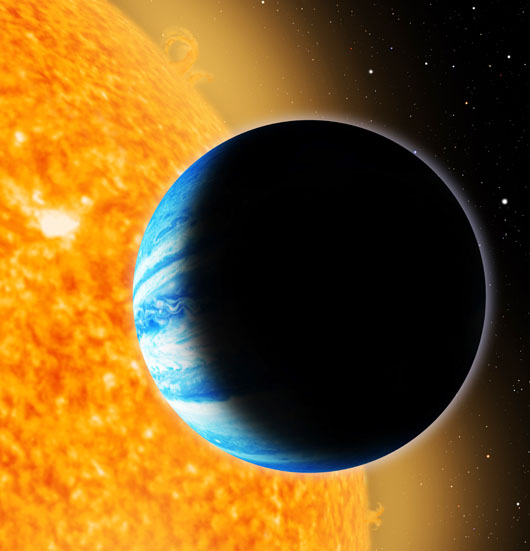Students play key role in new planet discovery
Students observing the night skies in between snowstorms in St Andrews are part of the international team that has discovered a new planet.
St Andrews PhD students Grant Miller and David Brown used Scotland’s largest optical telescope, the 0.9m diameter James Gregory telescope at the campus observatory, to confirm the presence and measure the diameter of the new planet, thus contributing to the discovery of a ‘new alien world’.

Artist’s impression of Qatar-1b (Credit: David Aguilar, CfA)
In a report published today (Tuesday 14 December), the St Andrews team helped to find the new planet in record time thanks teamwork and internet communications among astronomers in Qatar, the States, Germany, Denmark, and closer to home at the Universities of Leicester and Keele. The group highlight this discovery as a good example of successful collaboration across international borders and time zones.
The planet found, a ‘hot Jupiter’, now named Qatar-1b, adds to the growing list of alien planets orbiting distant stars, or exoplanets discovered by scientists around the world. The international team say that the new discovery demonstrates the power of science in crossing political boundaries and increasing ties between nations.
Building on UK technology developed for the SuperWASP exoplanet survey, the St Andrews and Leicester teams worked with closely with Dr Alsubai at the Qatar Foundation for Education, Science and Community Development. Together they processed raw images from the Alsubai cameras, extracting and sifting through data from hundreds of thousands of stars.
To find the new world, Qatar’s wide-angle cameras (located in New Mexico) took images of the sky every clear night beginning in early 2010. The digital images then were transmitted to the UK for computer analysis by collaborating astronomers at St Andrews and Leicester Universities and Dr Alsubai in Qatar. That analysis narrowed the field to a few hundred candidate stars.
Over a period of time, some planets will temporarily and periodically block the light of the parent star they orbit as they pass directly between that star and the Earth. These ‘transit’ events produce a characteristic dip in the light from the star that then reveals the orbiting planet. Of the vast number of stars observed, only a few will have detectable planets.
St Andrews astronomer Professor Keith Horne said “Qatar-1b is just the beginning. With Qatar’s new planet-hunting cameras, we should soon be finding smaller planets as well, hot Saturns and hot Neptunes, and ultimately, with a different technique, cool Earths.”
The group followed up on the most promising candidates with Dr David Latham, of the Harvard-Smithsonian Centre for Astrophysics, making observations from Arizona to weed out binary-star systems with grazing eclipses that can mimic planetary transits. The resulting data measured the mass of the new planet.
Qatar-1b is a gas giant planet, twenty percent larger than Jupiter in diameter and ten percent more massive. It belongs to the ‘hot Jupiter’ family because it orbits 3.5 million km from its star, so close that it roasts at a temperature of around 1100 degrees Celsius. The oribital period is just 34 hours.
Dr Latham commented, “The discovery of Qatar-1b is a wonderful example of how science and modern communications can erase international borders and time zones. No one owns the stars. We can all be inspired by the discovery of distant worlds.”
ENDS
Note to Editors
The researchers are available for interview:
Professor Andrew Cameron, Tel: 01334 463 147, Mob: 0783 453 5340 or email: [email protected]
Professor Keith Horne, Tel: 01334 463 322, Mob: 0777 072 8321 or [email protected]
Further information
From Tuesday 14 December a preprint of the paper will be available at http://star-www.st-and.ac.uk/~kdh1/qatar1.html
Note to Picture Editors
An artist’s impression of the exoplanet Qatar-1b can be downloaded from http://star-www.st-and.ac.uk/~kdh1/qatar1.html
Credit: David Aguilar, CfA
Issued by the Press Office, University of St Andrews
Contact Gayle Cook, Senior Communications Manager on 01334 467227 / 462529, mobile 07900 050 103, or email [email protected]
Ref: New planet 141210
View the latest University press releases at www.st-andrews.ac.uk
Category Research